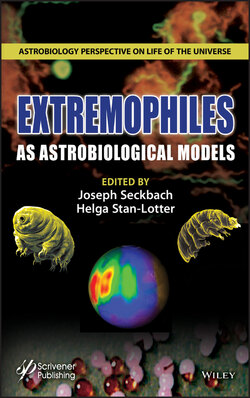Читать книгу EXTREMOPHILES as Astrobiological Models - Группа авторов - Страница 36
2.3 Rio Tinto Basin
ОглавлениеSize (92 km long), pH (mean pH 2.3), high concentration of heavy metals (Fe, Cu, Zn, As…) and a high level of microbial diversity, mainly eukaryotic, make Rio Tinto an uncommon extreme acidic environment [2.72] [2.5] [2.6] [2.57] [2.2] [2.3] [2.13] (Figure 2.1). Rio Tinto rises in Peña de Hierro, in the core of the Iberian Pyrite Belt (IPB) and merges with the Atlantic Ocean at Huelva. The IPB is a geological unit 250 km long and 60 km wide located in the northernmost zone of the Variscan Iberian Massif. The IPB is one of the largest sulfidic deposits on Earth. Massive bodies of pyrite and chalcopyrite, as well as minor quantities of lead and zinc sulfides, constitute the main mineral ores of the IPB [2.17] [2.69]. Hydrothermalism during the Hercynian orogenesis was responsible for its generation [2.17] [2.70]. In the 1700 km2 river basin three zones can be clearly defined according to their chemical and geological characteristics: the northern (from Peña de Hierro to Niebla), the transitional (from Niebla to San Juan del Puerto) and the estuarine (from San Juan to the Atlantic Ocean). The last zone can be considered to have the most extreme conditions detected in the Tinto basin, because the microorganisms thriving in this part of the river have to face drastic changes in pH, from around 3 to neutrality, as a consequence of the twice daily tidal influence of the Atlantic Ocean [2.103]. Climographs exhibit characteristic basin bimodality, with humid and temperate periods (fall, winter and early spring), alternating with dry and warm periods (late spring and summer).
Figure 2.1 View of colorful filamentous algae in the red waters of the origin of Rio Tinto. (Image credit: the authors).
Oxygen content varies from saturation to strict anaerobic conditions, which agree with the range, -280 to +650 mV of redox potentials measured. The comparison with other local rivers indicates that the acidity and the concentration of iron in the Tinto basin are at least one order of magnitude higher than the acidic Odiel and Agrio rivers, both also associated with mining activities [2.72].
A peculiar characteristic of the Tinto ecosystem is its rather constant pH, which is the consequence of the buffer capacity of ferric iron.
(2.1)
When the river is diluted by neutral tributaries or rain, hydrolysis of ferric iron occurs, precipitating ferric hydroxides and generating protons. In the summer, intense heat evaporates the water in the river and protons are consumed, dissolving the ferric hydroxide precipitates. Due to this buffering capacity a pH of around 2.3 remains constant along the river course with the exception of the estuarine zone. Its dimensions and relatively easy access make the Tinto basin an excellent model for the study of microbial ecology associated with an extreme acidic environment [2.12].
